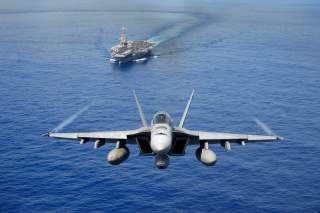The Next Threat to U.S. Navy Aircraft Carriers: Russian 'Nuclear' Torpedoes?
Or is this just fake news?
TASS also reports the Poseidon, -- the name was chosen in a Web contest held by Russia’s Ministry of Defense – will be armed with a 2-megaton warhead. That’s more than enough to destroy a city.
(This first appeared in December.)
Russia has begun underwater tests of its Poseidon thermonuclear torpedo.
The Poseidon is an 80-foot-long nuclear-powered submersible robot that is essentially an underwater ICBM. It is designed to travel autonomously across thousands of miles, detonate outside an enemy coastal city, and destroy it by generating a tsunami.
"In the sea area protected from a potential enemy’s reconnaissance means, the underwater trials of the nuclear propulsion unit of the Poseidon drone are underway," an unnamed Russian defense official told the TASS news agency.
The source also said the “the reactor is installed in the hull of the operating drone but the tests are being held as part of experimental design work rather than full-fledged sea trials at this stage.”
TASS also reports the Poseidon, -- the name was chosen in a Web contest held by Russia’s Ministry of Defense – will be armed with a 2-megaton warhead. That’s more than enough to destroy a city. But that leaves the question of why Russia would choose to nuke an American city with an underwater drone – even one that allegedly travels 100 miles an hour – when an ICBM can do the job in 30 minutes.
Russia suggests the Poseidon is a retaliatory weapon that would revenge a U.S. first strike even if American missile defenses were capable of stopping hundreds of Russian ICBMs. But even in the unlikely event that the U.S. could intercept 500 or more Russian ballistic missiles, a delivery system that could take days or weeks to reach its target seems hardly an efficient deterrent.
More intriguing is the suggestion that Poseidon could be used against U.S. aircraft carriers. A very fast, nuclear-armed drone could prove difficult for American anti-submarine defenses to stop. In a March 2018 speech, Russian President Vladimir Putin described his nation as being able to “move at great depths -- I would say extreme depths -- intercontinentally, at a speed multiple times higher than the speed of submarines, cutting-edge torpedoes and all kinds of surface vessels, including some of the fastest. It is really fantastic. They are quiet, highly maneuverable and have hardly any vulnerabilities for the enemy to exploit. There is simply nothing in the world capable of withstanding them.”
Putin added that Poseidon’s “nuclear power unit is unique for its small size while offering an amazing power-weight ratio. It is a hundred times smaller than the units that power modern submarines, but is still more powerful and can switch into combat mode, that is to say, reach maximum capacity, 200 times faster.”
Let’s also leave aside the question of why, if Russia really is that advanced in reactor design, its regular nuclear submarines aren’t so blessed. The puzzle is why a giant robot submarine would be needed to detonate a nuclear warhead near a U.S. aircraft carrier (presumably Poseidon is too expensive to waste by arming it with a mere high-explosive warhead). If the goal is to sink a U.S. carrier, couldn’t Russia saturate a carrier’s defenses with a volley of conventionally-armed hypersonic missiles like the Mach 5-plus Khinzal? And if nukes are being used, Russia has no shortage of missiles, bombs and aircraft to target American ships.
Whether Poseidon adds much to Russia’s strategic nuclear forces is doubtful. No less is doubtful is Poseidon the Carrier-Killer.
Michael Peck is a contributing writer for the National Interest. He can be found on Twitter and Facebook.


